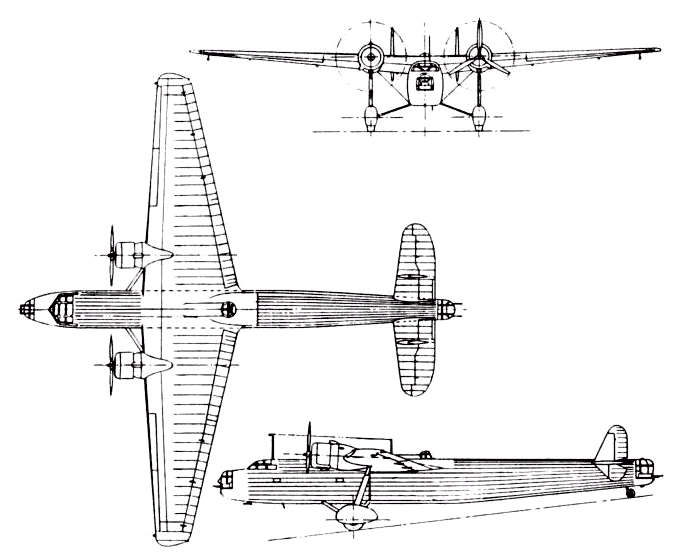- Yes
- No
Handley Page H.P.54 Harrow Mk.II

Design and service history:
The Handley Page H.P.54 Harrow was an interwar heavy bomber from Handley Page, that would be operated by the RAF during the Second World War, though interestingly not in its intended bomber role. The Harrow itself was not a completely new design, and was derived from the earlier Handley Page H.P.51, which was the company’s unsuccessful attempt at a monoplane bomber/transport hybrid aircraft. The H.P.54 came about due to air specification B.29/35 in 1935, which sought a stop-gap heavy bomber for the RAF bomber squadrons. HP updated the design of the H.P.51 to include several more modern features and simplified structural elements to enable more rapid production. Some of the modern features added included hydraulically powered turrets, steam-based cabin heating and variable pitch propellers, though the performance of the Harrow did not match contemporary designs that were made from the ground up to be bombers.
Happy with the design, in 1936 the Air Ministry ordered 100 Harrows for RAF service, with the FAA also ordering a 100 Harrows, though ultimately only 100 would be manufactured, as the FAA order would be cancelled. The RAF 100 would include two different variants with 19 following the initial design with a Pegasus X powerplant known as the MK.I, and 81 of the faster and more capable Pegasus XX-powered MK.II. The first Harrow would be delivered at the start of 1937 with the entire production run for the RAF delivered that year, though it would not see bomber service long, as by the end of 1939 it had effectively been replaced as a front line service with more capable designs, leaving the Harrow to revert back to the transport aircraft design of its predecessor, and would see service until the end of the conflict, finally being withdrawn with 5 remaining aircraft in may of 1945.
In terms of design, the Harrow is a textbook stopgap aircraft. It was derived from an existing design, which itself was a monoplane conversion of an older three-engined biplane designed the Handley Page H.P.43. The design is often confused as an answer to Air Ministry Specification B.9/32, which was a request for a specialised medium bomber that would ultimately result in the Vickers Wellington. The Harrow was instead the result of the RAF wishing to expand, and production of superior designs could not meet requirements, with the focus instead being on rapid production, compared to the more desirable performance of the Harrow’s front-line peers.
Despite this seemingly subpar design philosophy, the Harrow was no slouch, and came furnished with several modernisations, along with a respectable payload and defensive guns in 3 positions. The nose and tail turrets were powered, along with a manually operated dorsal turret. A bombadier sat in the nose, a last minute modification after an accident involving 7 Heyford bombers performing forced landings in a single flight during bad weather. The initial design had intended for these guns to be Lewis guns, but these were replaced during operational service with Vickers K machine guns. Interestingly in order to speed up production deliveries and to allow time to get the hydraulically powered turrets working properly, early production units were delivered to training squadrons without their turrets.
In terms of bomb load, the Harrow possessed a maximum bomb load of 3,000 lb (1,400 kg), which was stowed in a bay directly underneath the floor of the cabin. The Harrow could carry all bombs in RAF service up to the 2,000 lb (910 kg) bomb, giving it a wide range of payload options. The design was sluggish though, only able to initially achieve a top speed of 190mph, so in order to improve this, the 20th airframe onwards was powered by a more powerful pair of Bristol Pegasus XX radial engines, capable of producing up to 925 hp (690 kW). This increased and improved the aeroplane’s handling and it became the main version of the aircraft, known as the MK.2. All in all the Harrow was just one of a myriad of interesting stopgap bombers produced by the RAF in the mid 1930’s though unlike most other designs it found success in other roles, allowing it to outlive its competitors, and see the end of the war in Europe.
Aircraft Specification:
General characteristics


Crew: 5
Capacity: 20 fully equipped soldiers or 12 stretcher cases (used as transport)
Length: 82 ft 2 in (25.04 m)
Wingspan: 88 ft 5 in (26.95 m)
Height: 19 ft 5 in (5.92 m)
Wing area: 1,090 sq ft (101 m2)
Empty weight: 13,600 lb (6,169 kg)
Gross weight: 23,000 lb (10,433 kg)
Powerplant: 2 × Bristol Pegasus XX nine-cylinder air-cooled radial piston engines, 925 hp (690 kW) each for take-off
Propellers: 3-bladed variable-pitch propellers
Performance
Maximum speed: 200 mph (320 km/h, 170 kn)
Cruise speed: 163 mph (262 km/h, 142 kn)
Range: 1,260 mi (2,030 km, 1,090 nmi)
Service ceiling: 22,800 ft (6,900 m)
Rate of climb: 710 ft/min (3.6 m/s)
Wing loading: 21.1 lb/sq ft (103 kg/m2)
Power/mass: 0.0804 hp/lb (0.1322 kW/kg)
Armament
Guns: 4 × 0.303 in (7.7 mm) Vickers K machine gun, one in nose, one in dorsal turret, two in tail.
Bombs: Up to 3,000 lb (1,400 kg) of bombs internally. The largest bomb type being the 2,000 lb (910 kg) bomb.
Historical Photos and other images:





Sources:
- Handley Page H.P.54 Harrow - Wikipedia (Wiki page for the type)
- HP-54 Harrow (Additional history)
- Handley Page HP.54 Harrow Heavy Bomber Aircraft (Additional history)
- Handley Page Harrow | Classic Warbirds (Additional history)
- Handley Page H.P.54 Harrow - bomber, transport (More history)
